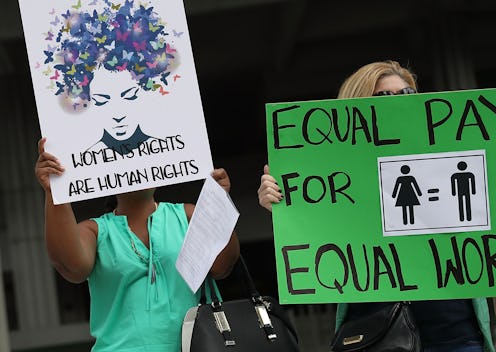A new study from the National Women’s Law Center (NWLC) brings to light one fact we often overlook when we talk about the wage gap: it's not just about gender. According to the NWLC's analysis of U.S. Census Bureau data, the average Latina makes over a million dollars less than the average white man over the course of a 40-year career. That's over twice as much as the average difference of $430,480 between men and women. Black women also have a larger wage gap than the average white woman, making $877,480 less over 40 years than the average white man. These statistics highlight the fact that there isn't just a gender pay gap (although of course there is, and of course it's an issue) — there are also wage gaps based on race, sexual orientation, gender identity, age, and ability. And they, too, are major problems.
These statistics remind us why feminism needs to be intersectional: The same issues affect different women differently depending on other identities they hold. When we talk about the wage gap, we can't just consider how it affects white, cisgender women — we have to talk about how it affects women of color, transgender women, and more, for example, as well as how pay discrimination might affect people of other genders depending on their individual circumstances.
Here are a few reminders that when we talk about equal pay, we're talking about a whole lot more than gender.
1. Trans Women's Wages Drop By A Third After They Transition
A study in the B.E. Journal of Economic Analysis & Policy found that after transgender women transitioned from presenting as men to presenting as women, their wages dropped by a third on average. This difference is larger than the 81 percent gap between men's and women's earnings in 2006, when the study was published. Revealingly, when trans men transitioned, their wages increased slightly, though not to the level of cis men's. These findings are consistent with the widespread workplace discrimination trans people face.
This study also provides proof that the gender wage gap really is the result of sexism. People often speculate that we can chalk it up to other factors like women negotiating less or spending more time with their kids, but here, we're talking about the exact same person, and their pay decreased when the only thing that changed was their gender presentation.
2. Gay Men Make 10 To 32 Percent Less Than Straight Men
According to a meta-analysis by The Williams Institute, different studies have found that gay men make between 10 and 32 percent less money that straight men. For whatever reason, most studies have found that lesbian women make as much money as straight women or more, though they still make less than men.
3. Black And Hispanic People Make Less Money Than White People
Women may make less money than men on average, but white and Asian women actually make more than black and Hispanic men. According to U.S. Bureau of Labor statistics, the average female American full-time worker makes $719/week, whereas the average black man makes $680, the average black woman makes $611, the average Hispanic/Latino man makes $616, and the average Hispanic/Latina woman makes $548. Though women of every race make less than men of their own race and black and Hispanic make less regardless of gender, race and gender intersect to produce the final outcome, which is why we say "intersectionality."
4. Wages Drop After Age 65
It's common for people to retire around 65, since that's the age Americans begin receiving full retirement benefits, but according to the Bureau of Labor Statistics, people over 65 make less even when they continue working full-time. Among full-time workers, the average weekly earnings at ages 65 and over are $740 for women and $942 for men, compared to $780 and $1,021 at ages 55-64. Age discrimination in the workplace and the hiring process is a rampant problem, especially for women.
5. People With Disabilities Earn 75 Cents For Each Dollar People Without Disabilities Earn
People with disabilities are three times more likely to be unemployed than those without disabilities, and when they are working, they only earn three-quarters as much as those without disabilities, according to U.S. Census data. This means women with disabilities experience an even greater wage gap, like many oppressed groups that discussions of equal pay too often neglect.
